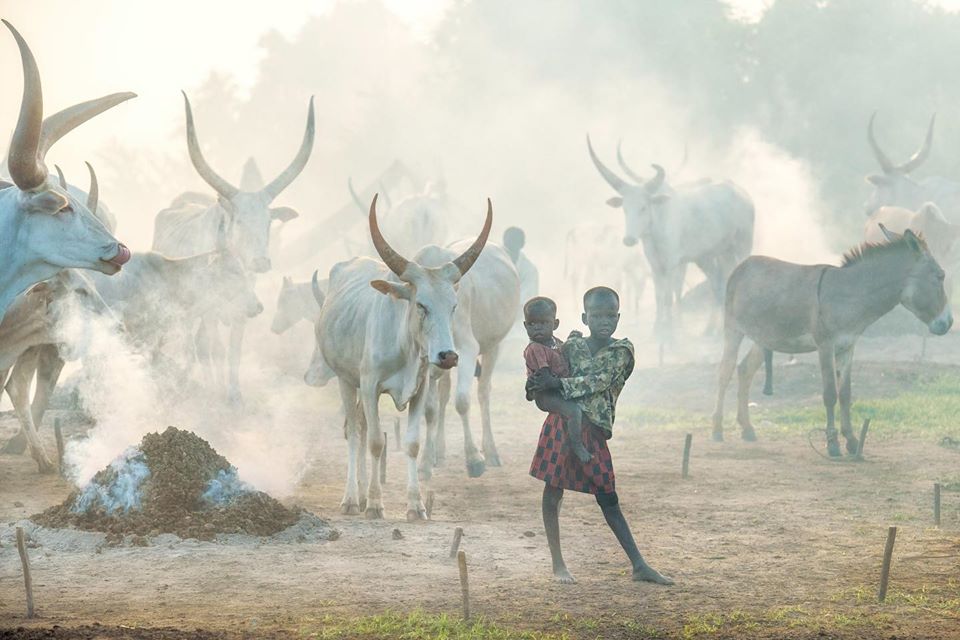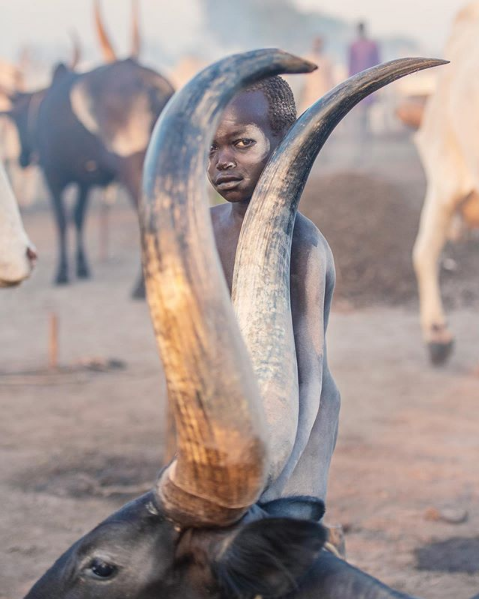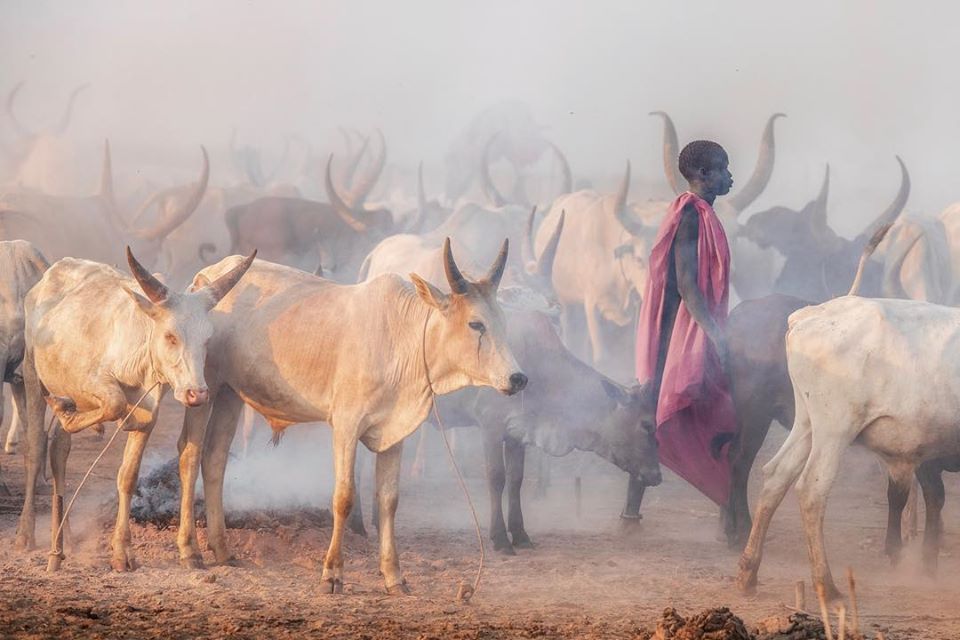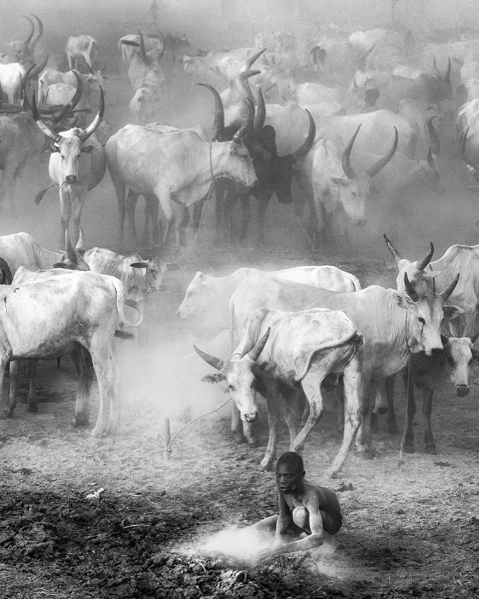Picture „Sudan – Dinka cattle camp“ thanks to © Courtesy of Trevor Cole (Ireland)
We regularly present different cultures from all over the world on our „Intercultural Network For The Highly Gifted“. Today we would like to present a section of impressions from life in Sudan. It is a great honor for us to be able to present Mr. Trevor Cole’s photographs here.
Mr. Trevor Cole is Irish geography professor turned professional photographer. His journey started in Ireland and took him all around the globe. He spent 3 years of his life in Ethiopia. He was awarded photographer of the year by TPOTY for his South Sudan images.
Mr. Nikola Kostic´s interview with Mr. Trevor Cole on YouTube.
Photographer Trevor Cole wrote about this picture: „Life in a Dinka cattle camp. The smoke, fires and dust create a scene which is almost biblical. The symbiotic bond between man and the cattle is a scene to behold. They massage their Ankole Watusi cattle with ash and do it with care and affection. The dust applied to man and beast mitigates against insect bites. These people have a very sustainable existence and their connection with nature should be a message to us all. These ancient practices ensure harmony with the environment and have a small ecological footprint which is local and ensures cultural longevity.“
Auf unserem „Intercultural Network For The Highly Gifted“ stellen wir regelmäßig verschiedene Kulturen aus der ganzen Welt vor. Heute möchten wir einen Ausschnitt von Impressionen aus dem Leben in Sudan vorstellen. Es ist uns eine große Ehre, hier die außergewöhnlichen Fotografien von Herrn Trevor Cole präsentieren zu dürfen.
Herr Trevor Cole ist ein irischer Geographieprofessor, der zum professionellen Fotografen wurde. Seine Reise begann in Irland und führte ihn rund um den Globus. Er verbrachte 3 Jahre seines Lebens in Äthiopien. Für seine Bilder aus dem Südsudan wurde er von TPOTY zum Fotografen des Jahres gekürt.
Herr Nikola Kostics Interview mit Herrn Trevor Cole auf YouTube.
Fotograf Trevor Cole schrieb zum obigen Bild: „Das Leben in einem Viehlager in Dinka. Der Rauch, das Feuer und der Staub schaffen eine Szene, die fast biblisch ist. Die symbiotische Verbindung zwischen Mensch und Vieh ist eine Szene, die man gesehen haben muss. Sie massieren ihr Ankole Watusi-Vieh mit Asche und tun dies mit Sorgfalt und Zuneigung. Der Staub, der auf Mensch und Tier aufgetragen wird, wirkt gegen Insektenstiche. Diese Menschen leben sehr nachhaltig und ihre Verbindung zur Natur sollte eine Botschaft an uns alle sein. Diese alten Praktiken sorgen für Harmonie mit der Umwelt und haben einen kleinen ökologischen Fußabdruck, der lokal ist und kulturelle Langlebigkeit gewährleistet.“
Mundari and Dinka cattle camps on the Nile and to the Topossa tribe in Eastern Equatori
Picture „Sudan – Terekeka County“ thanks to © Courtesy of Trevor Cole (Ireland)
Photographer Trevor Cole wrote about this picture: „Mundari boy framed. The Mundari, when covered with ash they appear as apparitions or ghosts especially when their is dust and smoke in the air. They gather the dung in the morning, dry it by spreading it out and then use it as fuel for their fires. And so this cyclical use of ash continues. The men also shower using the urine of their cattle which acts as an antiseptic and colours their hair orange! These people have a very sustainable existence and their connection with nature should be a message to us all. These ancient practices ensure harmony with the environment and have a small ecological footprint which is local and ensures cultural longevity.“
Mundari and Dinka cattle camps on the Nile and to the Topossa tribe in Eastern Equatoria.
Picture „Sudan“ thanks to © Courtesy of Trevor Cole (Ireland)
Photographer Trevor Cole wrote about this picture: „Mundari existence. Shooting at dawn and dusk is perfect as all the cattle are in place. The more you see, the more you realise that there is an inextricable bond between the tribe and their cattle. The way they lead them, rub ash into their skins, attend to their needs, use their milk, dung and urine. It is a symbiotic relationship where there is an understanding of the cattle which goes beyond normal animal husbandry. They take pride in their animals and the whole community of man and beast is interconnected. I have never seen anything like it. On the previous evening the air was filled with smoke from the dung and kindle wood fires to keep insects at bay. The dust is used to help dry the dung which is laboriously collected and piled in the mornings. It is then dried as fuel. As the sun sets in African style the light, smoke and dust create an ethereal atmosphere which makes it appear that the Mundari and their cattle fade into a mist. An ancient mist, trapped in time, where tribal traits and traditions are perpetuated in the twenty first century.“
Picture „Sudan“ thanks to © Courtesy of Trevor Cole (Ireland)



